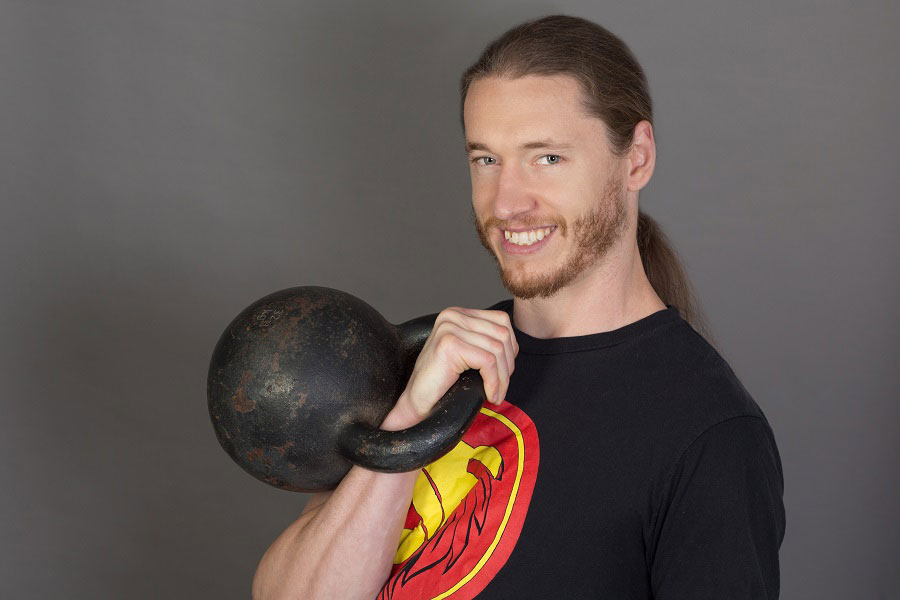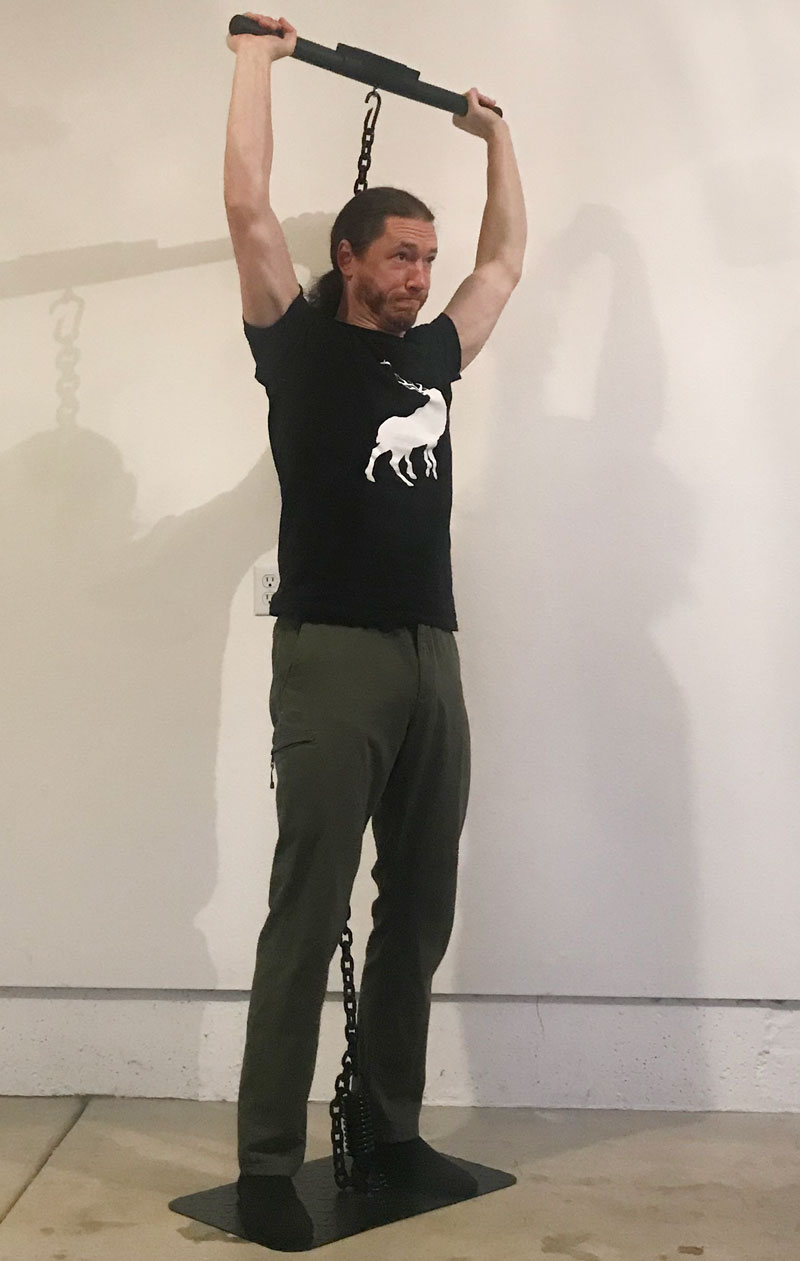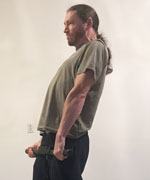Build Your Strengths and Weaknesses with the Isochain
By Logan Christopher

I’ve been in the iron game for almost 20 years now (including the
kettlebell and bodyweight game). Over the years I have used all manner of isometrics from time to time. Everything from muscle control, to bodyweight holds, to self-resistance, to beyond heavy weights in the power rack.
But they have never been the mainstay of my training, for one reason and one reason only. The fatal flaw of unmeasurable progression.
I’m constantly reiterating to my trainees that training, be it for strength, endurance, flexibility, speed, etc. is all about progression. That’s the name of the game, to get you from point A, where you are, to point B, where you want to be.
Not being able to measure that progress makes things tricky. So, at best, isometrics were like a spice I would use to flavor the main dish of some form of isotonic movement.
So when I saw the
Isochain, that it had fixed this fatal flaw, I immediately pre-ordered it and waited as patiently as I could. I was fortunate to receive it in the middle of August…which turned out to be great timing among an otherwise poor time.
Life had something in store for me as my house burned down in one of the many California wildfires. Fortunately, no one was hurt. And I had the foresight to grab the Isochain along with some other stuff when I evacuated. Glad I did!

What better time to use this then after my entire home gym burned down?
In these trying times it was great to follow a program without too much thought going into it. Being an intuitive trainer, this was the first time I’ve followed anything besides my own body’s guidance and personal goals in quite a while.
Enter the Prometheus II Program
I went with the Prometheus II program as covered in
The Ultimate Isometrics Manual, with occasional exercise substitutions.
The main difference is I cycled between a bottom, middle and top position on each exercise rather than just sticking to a single position.
The only other training I did at this time was my newest course,
7 Minute Flexibility, which I would do on some days after the Isochain workout, or on my off days.
Overall, the Isochain is simple to get up and running with. That being said I did feel like it took about two weeks until my body was really in the groove with most of the exercises and different positions. For me, it took about two weeks to get neurologically adapted to the device.
Part of that was that
like Dan John, I found sustaining power for six seconds tough! So much easier for me to hit a max then stop pushing. So much easier to lift a weight where momentum can carry you past a sticking point.
It was after about two weeks that I started to get pretty sore from the workouts. This despite the fact that isometrics overall produce less soreness then moving weights. Not super sore to the point of not being able to walk straight (I think we’ve all been there at some point) but certainly noticeably so.
Since then, that has gone back down but it does speak to me using some areas in new ways that my body wasn’t quite used too. Once I was neurologically adapted to the Isochain I could truly start to exert maximum strength.
This shows two workouts about six weeks apart and the progress between them. (All weight numbers refer to pounds.)
8/24/20
- Deadlift bottom 185 x 6s x 6
- Curl middle 65 x 6s x 6
- Press bottom 115 x 6s x 6
10/6/20
- Deadlift bottom 225 x 6s x 6 Max x 267
- Curl middle 90 x 6s x 6 Max x 121
- Press bottom 180 x 6s x 6 Max x 250
One thing I liked to do while engaging in the 6 second by 6 reps program was to also aim for a new max during that. Usually it would happen in the second or third set. And then I’d ease off a bit while still hitting the target load the rest of the set.
Do These Isometrics Carry Over?
The self-comparison on the Isochain is one thing. What about outside of it?
Unfortunately, I no longer had much equipment to try my strength elsewhere. One thing I could do was handstand pushups against a wall. My previous best ever in doing this was 20 reps.
And without practicing this move at all for months, I managed to beat that previous all-time PR hitting 21 reps.
Yes, the strength transfers!
Pointing Out My Weaknesses
Not only was I getting great results but I felt like this training helped point out some of my weaknesses.
In addition to the six second exertions in a static position, another weakness is that I feel much better suited to deadlifts then squats. At 6’2", I’m tall and lanky.
Because of all I’ve done over the years I have a crazy strong lower back. Round back deadlifting suits me. I’ve done heavy and odd position kettlebell juggling feats. This is great…except that sometimes my back takes over for the legs.
One area I was getting sore in was the low back early on. Most specifically, I struggled with the front squat position. Some days I substituted Zercher squats which I felt stronger in. But I kept working at the front squat position. Lately, I’ve been doing longer holds, up to a minute long (brutal!) and really feel like I’m getting the groove on this exercise.
For as strong as I am overall, my squatting ability pales in comparison. But I think that working with the Isochain I’ll better bring up this weakness than I ever have previously.
For instance, when I first tried maxing out in the bottom position of the front squat, I scored a paltry 164 max. Since that time, it has gone up to 220. Not only that but I did 165 x6s x6, which was just over my initial max!
Personalizing the Movements and Some Tips
I want to share a couple of things that I’ve learned that might be helpful to others.
When training the top position of a press I put the chain behind my body rather than the front. In this way it is more like a behind the neck press. This position feels better to me and I can exert higher strength in it.

Having done a very short-range rack pull of 1025 lbs. I haven’t come close to that much on the Isochain. One thing that stops the highest level of force production is that you’re uprooting yourself as you pull. With this kind of pressure, on the Isochain the plate that you’re standing on bows upwards.
Something I’ve been playing with on the deadlifts, especially top position, is placing heavy kettlebells on the plate in the front and back to help resist this allowing a stronger pull.
Thus far, my best on the top range deadlift, really more of a health lift, on the Isochain is 533 lbs.
Visualization, as I cover extensively in
Mental Muscle, works great for training with the Isochain. Visualizing yourself doing the exercise is obvious, but I’d also recommend:
- Imagining hearing the beeps loudly for any of the timed or load settings.
- Seeing the readout on the digital display with higher numbers when aiming for a max or average.
Moving Forward…
As I mentioned, I’m mostly an intuitive trainer. Since completing six weeks of the Prometheus II program I’ve been continuing to use the Isochain. However, I’m working in more different exercises (shrugs, finger holds, Bulgarian split squats, etc).
I’m also working in the other settings such as ‘Average’ and the aforementioned longer time frames. The longer holds on the squats are paying some bigger dividends for me so I imagine that will carry over to other exercises too.
I love all the different training tools. I love barbells. I love kettlebells. I definitely love
bodyweight training.
And I love the Isochain!
Even when I have a rebuilt and fully stocked gym, I believe this will be a tool that I’m using regularly from here on out.
 Born without genetic gifts, a weak and scrawny Logan Christopher sought out the best training information in his pursuit of super strength, mind power and radiant health. Nowadays, he’s known for his famous feats of pulling an 8,800 lb. firetruck by his hair, juggling flaming kettlebells, supporting half a ton in the wrestler’s bridge and more. He is the author of many books, including Mental Muscle, published by Dragon Door Publications. You can find more from him at LegendaryStrength.com as well as his performance herbalism company at www.LostEmpireHerbs.com.
Born without genetic gifts, a weak and scrawny Logan Christopher sought out the best training information in his pursuit of super strength, mind power and radiant health. Nowadays, he’s known for his famous feats of pulling an 8,800 lb. firetruck by his hair, juggling flaming kettlebells, supporting half a ton in the wrestler’s bridge and more. He is the author of many books, including Mental Muscle, published by Dragon Door Publications. You can find more from him at LegendaryStrength.com as well as his performance herbalism company at www.LostEmpireHerbs.com.
Back